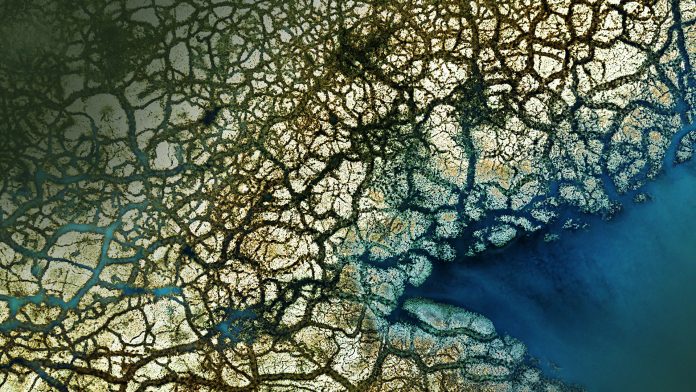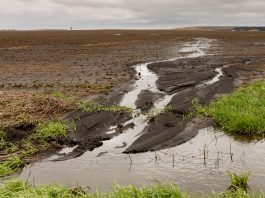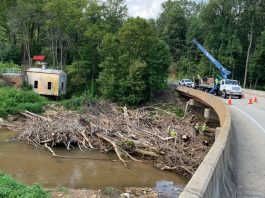Professor Bernd Lennartz from the University of Rostock investigates methods of reducing water contamination by developing solutions to agricultural runoff.
Ground and surface water quality is closely linked to land management and agricultural activity. It is now common knowledge that the fertilisation of agricultural fields may lead to the contamination of water resources, also known as agricultural runoff. But what exactly drives the transport of compounds applied to the soil surface to the groundwater? And why do we still observe the contamination of water resources despite an optimised and plant-growth-depending fertiliser management? Also, what can we do in a highly productive agricultural system to avoid the transport of nitrogen and phosphorous to water resources? These are central questions leading the research of Professor Bernd Lennartz and his working group at the Department of Agricultural and Environmental Sciences, University of Rostock, Germany.
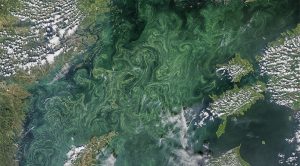
Ever-expanding death zones in the Baltic Sea and the Gulf of Mexico
Nitrogen- and phosphorus-based fertilisers fuel our agriculture and ensure a stable crop production. Negative side effects of such an intensive agriculture may, however, compromise environmental assets, especially soil and water resources. High nutrient concentrations in lakes and oceans alike boost annual algae blooms with often disastrous consequences. Algae blooms can be extensive, some of them visible even from space (see Fig. 1). The produced algae biomass eventually sinks to the seafloor, where its bacterial decomposition consumes oxygen. When the oxygen is depleted entirely, the sea floor turns into a ‘dead zone’ where it is nearly impossible for any life to survive. Expanding dead zones as a result of eutrophication processes have been reported for the Baltic Sea and the Gulf of Mexico alike (van Meter et al., 2018).
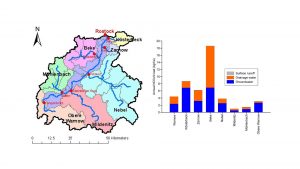
Only long-term and high-resolution data ensure process identification
In industrialised countries in Europe and the USA, the riverine nutrient export to the oceans has stabilised or even decreased during the last decades. The observed reduction in nutrient loading of surface waters, especially with nitrogen and phosphorus, resulted primarily from the upgrading of sewage systems in the 1990s. The technological progress in the cleanup of wastewater has shifted the origin of nutrient loadings from point to diffusive sources. The diffusive pathway is defined as the field-scale export of compounds from (agriculturally used) land and the entry into waters along the entire length of brooks and rivers. Today, the vast majority of the nutrient loading in rivers originates from agricultural sources.
To better understand the processes driving the input of nutrients into waters, long-term data is required. A robust database with decadal-long time series of concentration values of ground and surface waters allows for the identification of primary pathways in the landscape. With this data at hand, it also becomes possible to construct and optimise simulation models, which depict the processes of nutrient transport from the agricultural field to the ocean.
Modelling studies of the Warnow river basin, a 3,000km2 catchment in the northern German lowlands, revealed the significant role of tile drainage systems on nutrient export processes (Bauwe et al., 2019a; Koch et al., 2018; Fig. 2). The artificial and systematic drainage of agricultural fields is widespread throughout northern Europe and the UK and facilitates a highly productive agriculture. Tile drainage systems assure aeration and trafficability of soils in early spring but seems to also accelerate nutrient transport through the soil and to surface water bodies.
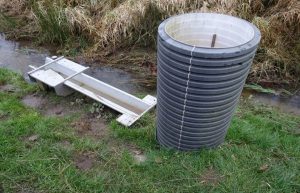
The water regime is everything (highways through the soil)
Long-term investigations and the analysis of nutrient budgets have shown that conventional crop production under current law is based on a nitrogen surplus. The nitrogen surplus, also named ‘nitrogen balance’, is the difference between the nitrogen mass that is applied to the soil surface with organic and inorganic fertilisers and the amount of nitrogen that is exported from the field via the crop. The nitrogen balance was as high as a 100kg N ha-1 a-1 for decades (BMEL, 2019) but has been regulated down to 60kg N ha-1 a-1 in Germany (DüV, 2017). The nitrogen surplus remains in the soil, is in part denitrified (converted to nitrogen gas), incorporated into the soil organic matter and is partially leached down to the groundwater. We intuitively assume that a high nitrogen surplus leads inevitably to high concentrations and loads in ground and surface waters. Such a relation can, however, not be proven from annual data sets. We could not find any relation between the nitrogen balance of a specific year and the nitrogen export of that year via the tile drainage path (Bauwe et al., 2020 – currently under review).
Trying to link the nitrogen balance of the last or penultimate year to the current nitrogen leaching situation did not improve relations. The yearly water regime and the annual discharge volume were the only parameters that could be identified as drivers for the leached nitrogen fraction (Bauwe et al. 2020 – currently under review). It is worth noting that with any increase in discharge, nitrogen concentrations likewise rise pointing to massive soil nitrogen stocks. The possible impact of nitrogen surpluses on nitrate export rates is overridden by the hydro-meteorological conditions in the catchment.
Phosphorus is known for being strongly retained in soils. The phosphate ion gets adsorbed by clay minerals and soil organic matter. Recent investigations now confirm that depending on the water regime and especially on rainfall intensity, phosphorus may be transported vertically through the soil to ground and tile drainage water (Koch et al., 2019). The application of organic fertilisers is crucial in this process. It could be shown that after biogas digestate application, phosphorus was transported to deeper soil layers via preferential flow pathways (see Fig. 3). Depending on soil organic matter and soil structure, highly conductive routes establish in the soil, leaving large parts of the soil out in transporting water and solutes. As a consequence, phosphorus bypasses the soil where it is generally strongly adsorbed and enters the groundwater.
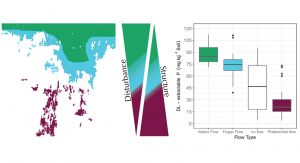
Are our water resources haunted by the past or the future?
River basin scale investigations show that sub-catchments that are dominated by crop production supply significantly more nutrients to the river than those under forest and grassland (Bauwe et al.,2019c). Landscapes with long-term crop production have been enriched with nutrients for decades. Any changes in land management will probably take similar times to become detectible in water quality. The strong affinity of phosphorus to inorganic and organic fine particles causes long residence times in soils and sediments and, therefore, prolonged leaching to the sea. This observation has been named ‘legacy effect’ and was first described for phosphorus. Currently, however, we are aware that a similar effect is to be expected for nitrogen. Nitrogen was transported to the Gulf of Mexico for decades even with hypothesized radical land management changes (Meter et al., 2016).
We should be aware of our past non-equilibrated management of nutrients in agricultural production. A glimpse into the future might even make us worry more. Global climate change and the projections of rainfall and temperature indicate a more Mediterranean-like climate for northern Europe and the UK. Mediterranean in this context means dryer summers with occasional high-intensity rainfall events and wetter winters with higher drainage volumes, both of which foster higher nutrient loadings of our rivers. It shall be emphasised that the sometimes controversial topic of climate change is not necessarily a gradual process with hardly tangible changes from one year to another. As experienced in 2018, 2019, and spring 2020, annual rainfall distribution is dramatically shifting from the long-term average patterns. All our efforts in revising fertiliser regulations shall consider legacy and climate change effects.
What can we do now to immediately improve water quality?
It should be stressed that we cannot only blame farmers for being responsible for an impaired water quality. Farmers are acting according to political and legislative boundary conditions. We need revised incentive schemes, which foster a socially and environmentally fair agriculture. A drastically modified management strategy with 50% less fertiliser input will disproportionally reduce nutrient concentrations in rivers as a recent modelling study could prove (Bauwe et al., 2019c). However, water quality will improve delayed and nitrogen, as well as phosphorus, will continue to leach for decades because of high nutrient stocks in soils and sediments.
So, there is nothing to be done about it? Not quite. In addition to a revised land management and a limited application of fertilisers to soils, so-called ‘water-based’ or ‘end-of-pipe’ solutions have come into focus for water quality improvements. The idea behind several newly developed techniques is to clean up contaminated water before it reaches rivers and eventually the ocean. This is, of course, only an option for landscape settings where agricultural runoff can be captured and treated. In this context, agricultural tile drainage systems, in which the soil access water is routed to ditches and brooks, offer excellent opportunities for water treatment.
Various filter systems and reactive barriers have been tested with varying success. In a more recent study, iron-coated sand has been analysed as an adsorbent for phosphorus (Bauwe et al., 2019b). A phosphorus retention device was installed at the outlet of a drainage pipe (see Fig. 4). Total phosphorus loads could be reduced by 20%, although the phosphorus concentration level was low. In general, these filter systems work best at high concentration input and low hydraulic loading (Bauwe et al., 2019b).
It is still to be seen if water-based clean up techniques will be established on a large scale. Denmark, for instance, has launched a nation-wide project with thousands of constructed wetlands to be installed. Until today, installations have been tested over short investigation times. Long-term monitoring studies confirming the general suitability of end-of-pipe solutions at field scale are still lacking.
References
- Bauwe A, Eckhardt K-U, Lennartz B 2019a.’ Predicting dissolved reactive phosphorus in tile-drained catchments using a modified SWAT model’. Ecohydrology and Hydrobiology 19(2), 198-209
- Bauwe A, Kahle P, Lennartz B 2019b. ‘Impact of filters to reduce phosphorus losses: Field observations and modelling tests in tile-drained lowland catchments’. Water (Switzerland) 11(12), 2638
- Bauwe A, Lennartz B 2019c.’ Landbewirtschaftung steuert Nitratausträge: eine Modellstudie’. Wassereitschaft 4, 14-21
- Bauwe A, Kahle P, Tiemeyer B, Lennartz B 2020. ‘Nitrogen export in tile-drained landscapes is linked to water balance rather than land management’. Submitted to Environmental Research Letters (currently under review)
- Bundesministerium für Ernährung und Landwirtschaft (BMEL) 2019. Statistischer Monatsbericht Kap. A Nährstoffbilanzen und Düngemittel, Nährstoffbilanz insgesamt von 1990 bis 2017 (MBT-0111260-0000)
- Kahru M, Elmgren R 2014. ‘Multidecadal time series of satellite-detected accumulations of cyanobacteria in the Baltic Sea’. Biogeosciences 11(13), 3619-3633
- Koch S, Kahle P, Lennartz B 2018. ‘Spatio-temporal analysis of phosphorus concentrations in a North-Eastern German lowland watershed’. Journal of Hydrology: Regional Studies 15, 203-216
- Koch S, Kahle P, Lennartz B 2019. ‘Biogas digestate application modifies solute transport conditions in soils and increases the release of phosphorus’. Vadose Zone Journal 18(1),190031
- van Meter KJ, Basu NB, Veenstr JJ, Burras CL 2016. ‘The nitrogen legacy: Emerging evidence of nitrogen accumulation in anthropogenic landscapes’. Environmental Research Letters 11 (3), 035014
- Van Meter KJ, Van Cappellen P, Basu NB 2018. ‘Legacy nitrogen may prevent achievement of water quality goals in the Gulf of Mexico’. Science 360(6387), 427-430
Professor Bernd Lennartz
Department of Agricultural and Environmental Sciences
University of Rostock
+49 (0) 381 498 3180
bernd.lennartz@uni-rostock.de
www.auf.uni-rostock.de/en
Please note, this article will also appear in the second edition of our new quarterly publication.

